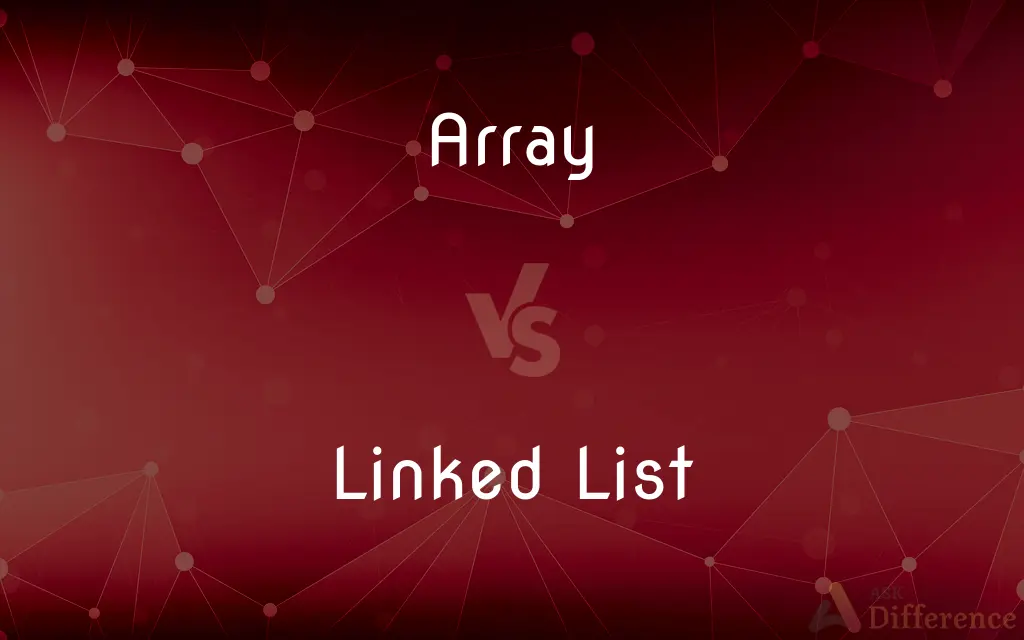Array vs. Linked List — What's the Difference?
By Tayyaba Rehman — Published on January 15, 2024
Arrays are collections of elements stored in contiguous memory locations. Linked Lists are sequences of elements, where each element points to the next, stored non-contiguously.

Difference Between Array and Linked List
Table of Contents
ADVERTISEMENT
Key Differences
An Array is a fundamental data structure that stores elements in contiguous memory locations. This arrangement allows for fast access to elements using their index, making arrays efficient for read-intensive operations. Linked Lists, however, consist of nodes where each node contains data and a reference (or link) to the next node. The non-contiguous storage allows for dynamic memory allocation.
Arrays have a fixed size, which means the size needs to be known beforehand and cannot be changed dynamically. They are efficient for indexing operations but resizing an array is costly as it involves creating a new array and copying elements. Linked Lists offer flexibility in terms of size; they can grow or shrink as needed, as each element is independently allocated in memory.
When it comes to insertion and deletion operations, Arrays are less efficient, especially at the beginning or in the middle, as shifting elements is required. Linked Lists excel in these operations as they involve only updating the links, making insertions and deletions more efficient.
Memory utilization is different in both. Arrays might allocate more memory than necessary if the exact number of elements is unknown. Linked Lists use extra memory for storage of the pointers, but they allocate memory as needed.
Arrays support random access, which means any element can be accessed directly if its index is known. Linked Lists, being sequential access structures, require traversal from the beginning of the list to access an element, which can be time-consuming for large lists.
ADVERTISEMENT
Comparison Chart
Memory Allocation
Contiguous; fixed size.
Non-contiguous; dynamic size.
Access
Random access (direct indexing).
Sequential access (traversal needed).
Insertion/Deletion
Less efficient (shifting required).
More efficient (updating links).
Memory Utilization
Can be inefficient (fixed size).
Efficient (allocates as needed, but extra for pointers).
Use Case
Efficient for indexed access and read-heavy tasks.
Ideal for insert-heavy tasks, flexible size management.
Compare with Definitions
Array
Fixed-size data structure, efficient for indexed access.
Created an array of integers to store temperature readings.
Linked List
Ideal for variable-sized collections of elements.
Implemented a linked list for the user's dynamically changing playlist.
Array
Requires knowing the size in advance.
Declared an array of size 10 to store user IDs.
Linked List
Does not support direct indexing.
Accessed elements in the linked list through sequential traversal.
Array
Suitable for applications with more read operations.
Used an array to store pixel values in an image for fast access.
Linked List
Allows for dynamic memory allocation.
Appended new nodes to the linked list as more data was received.
Array
Less efficient for operations like insertion and deletion.
Inserting a new element into the array required shifting the existing elements.
Linked List
Efficient for insertions and deletions.
Removed a node from the linked list without needing to shift other elements.
Array
A collection of items stored at contiguous memory locations.
Accessed the third element of the array using its index.
Linked List
A sequence of nodes where each node points to the next.
Traversed the linked list to find the node containing the key value.
Common Curiosities
Can Arrays grow dynamically?
Typically no, they have a fixed size, though dynamic arrays or vectors are exceptions.
What is an Array?
A data structure storing elements in contiguous memory locations.
What is a Linked List?
A collection of nodes where each node links to the next node.
Is random access possible in Linked Lists?
No, you need to sequentially traverse a Linked List.
Why use a Linked List?
For flexible sizing and frequent insertions/deletions.
Are Arrays faster than Linked Lists for access?
Yes, due to direct element indexing.
Can I insert elements in the middle of an Array efficiently?
No, this requires shifting elements and can be inefficient.
When should I use an Array?
When you need indexed access and size is fixed or changes infrequently.
What happens when an Array is full?
You need to create a larger array and copy elements, or handle overflow.
Can I use binary search on a Linked List?
It’s not practical due to the lack of direct indexing.
Do Linked Lists use more memory than Arrays?
Yes, due to storing additional pointers with each element.
How does deletion in Linked Lists compare to Arrays?
It’s more efficient in Linked Lists, as it just involves updating pointers.
How do Linked Lists handle memory allocation?
They allocate memory for each element separately, as needed.
Are there different types of Linked Lists?
Yes, including singly, doubly, and circular linked lists.
Are Arrays or Linked Lists better for stack implementation?
Both can be used, but Linked Lists offer more flexibility in size.
Share Your Discovery

Previous Comparison
MAC Address vs. IP Address
Next Comparison
PNG vs. JPGAuthor Spotlight
Written by
Tayyaba RehmanTayyaba Rehman is a distinguished writer, currently serving as a primary contributor to askdifference.com. As a researcher in semantics and etymology, Tayyaba's passion for the complexity of languages and their distinctions has found a perfect home on the platform. Tayyaba delves into the intricacies of language, distinguishing between commonly confused words and phrases, thereby providing clarity for readers worldwide.
















































